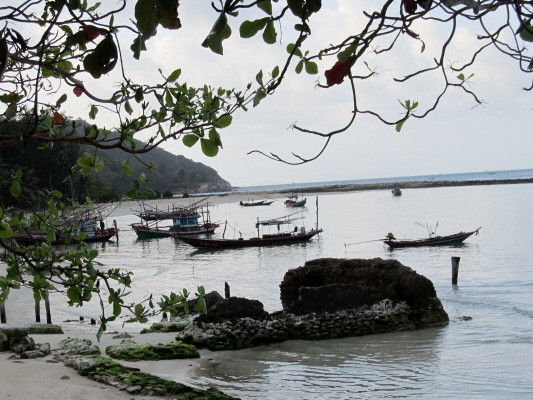The air was cool but humid as members of the Center for Oceanic Research and Education and I stepped onto the sand of a gently sloping beach on a small island in the Gulf of Thailand. We were starting work early, but we were not the only ones—a young man was getting up on a boat and stretching in the morning light. My boss leaned over to me and said, “I hope that’s not one of the trapped fishermen.”
He went on to explain that a number of the fishermen surrounding the island were sold into slavery and forced to stay on their boats indefinitely, fishing without release.
We looked out across the water every evening and watched as little green lights popped up while the sun sank below the horizon. The little green spots came from a myriad of squid boats, all using the light to attract squid. In that moment, the little lights went from a familiar sight to an uneasy feeling in the pit of my stomach.
I was reminded of the young man stretching in the morning light when the Pulitzer Prize Board announced the 2016 prizewinners on April 18. The award for public service went to the Associated Press for its exposé on Southeast Asian slaves, who are sold and taken to work in seafood markets that feed demand in nations like the U.S.
Over 2,000 slaves have been rescued from eastern Indonesia since the AP’s article, three class-action lawsuits have been launched, the Obama administration has put pressure on suppliers to step up anti-slavery protections and a massive fishing company has been shut down in Thailand and Indonesia.
These men faced brutal conditions prior to their rescue. Many survivors reported vicious beatings, relentless forced labor, dangerous working conditions, mental distress and deaths of fellow fishermen.
Part of the danger for these enslaved fishermen is simply that they are forced to be fishermen. The U.S. Bureau of Labor Statistics ranked fishing as one of the most dangerous occupations in 2013, second only to logging workers.
Over 70 fishermen died for every 100,000 employed in 2013, vastly outnumbering the number of construction workers, mining machine operators, police officers and firefighters killed on the job. Drowning, rough weather on the high seas and heavy equipment all pose a threat to the lives of fishermen.
The first step in righting this wrong is making sure U.S. markets source seafood from sustainable fisheries that observe fundamental human rights laws. In the long run, it may also mean reforming the way we harvest the ocean’s bounty.
In most of the commercial world, the days of non-recreational hunting expeditions are gone. Instead, industry has maximized fishing efficiency by creating highly controlled and regulated environments, whether those are in the form of farms, ranches or feedlots.
Fishermen, however, still risk life and limb to harvest a large enough supply of seafood to meet growing demand. As companies and countries race to harvest more fish than competitors, global stocks plummet, decreasing the next year’s fish quantities. Fishermen consequently increase their fishing capacity by investing in better detection and capture technologies.
Fishery scientists call the amount of time and materials needed to catch a certain level of fish the “catch per unit effort,” or CPUE, of a population. CPUE is used as a metric for the relative amount of a species left in a region, with the logic following that if technologies used to catch fish are held constant, the proportion of fish caught should remain relatively constant for a population.
If a fisherman sits on a boat every day for one year and catches 20 tuna, but the next year does the same thing and catches only 10, and the next year only catches three, it is reasonable to assume there are less tuna in his fishing spot.
Global CPUE has been declining since the late the 1900s, along with fish stocks.
The only thing increasing is fishing technology. Today, the global fishing fleet has enough capacity to fish Earth’s seas four times over.
But what if there was a different way to harness that technology? Fishing does not need to be the second most dangerous job in America; rearing terrestrial livestock, after all, certainly is not.
While initial aquaculture projects were criticized for their non-sustainable approaches to domesticating the sea, there is a growing movement to create integrated multi-trophic aquaculture projects that allow fishermen to raise stocks for human consumption, while simultaneously removing some pressure from wild populations. These systems reduce the impact of farming operations on neighboring ecosystems and allow for a diversified yield. Wild stocks simply do not have the capacity to feed the world’s hunger at the rate they are harvested.
The dangers fishermen face on a daily basis are real, and part of what made the AP exposé so impactful was the dangers the enslaved fishermen in Southeast Asia were forced to face at sea.
It may be time for nations to stop thinking about seas as the final wild frontier, but rather, start thinking of new sustainable ways to harvest fish without destroying the remaining wild populations left in the ocean. It is worth considering, for the sake of fish and fishermen alike.
Follow Julianna Renzi on Twitter.









